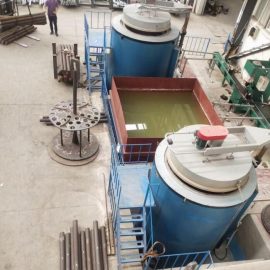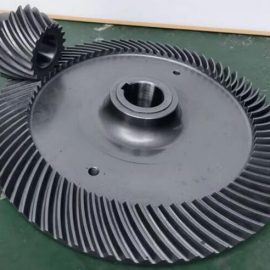The Principle And Classification Of Quenching Process
The quenching process is widely used in the modern machinery manufacturing industry. Important parts in machinery, especially steel parts used in automobiles, airplanes, and rockets, are almost all quenched. In order to meet the technical requirements of various parts, various quenching processes have been developed. For example, according to the part to be treated, there are overall, local quenching and surface quenching; according to whether the phase transformation is complete during heating, there are complete quenching and incomplete quenching (for hypoeutectoid steel, this method is also called subcritical quenching); according to cooling The content of the phase transition includes graded quenching, isothermal quenching and under-speed quenching.
The technological process includes three stages of heating, heat preservation and cooling. Taking the quenching of steel as an example, the principles of the selection of process parameters in the above three stages are introduced.
The heating temperature is based on the critical point of phase transformation of the steel. During heating, small and uniform austenite grains should be formed, and a fine martensite structure will be obtained after quenching.
In actual production, the choice of heating temperature should be adjusted according to the specific situation. For example, the carbon content in hypoeutectoid steel is the lower limit, when the furnace load is large and the depth of the hardened layer of the part is to be increased, the upper temperature limit can be used; if the workpiece has a complex shape and strict deformation requirements, the lower temperature limit should be used.
The holding time is determined by various factors such as equipment heating method, part size, steel composition, furnace load and equipment power. For overall quenching, the purpose of heat preservation is to make the internal temperature of the workpiece uniform and consistent. For all types of quenching, the holding time ultimately depends on obtaining a good quenching heating structure in the area requiring quenching.
Heating and heat preservation are important links that affect the quality of quenching, and the microstructure obtained by austenitization directly affects the performance after quenching. – The austenite grains of general steels are controlled at grades 5 to 8.
Cooling method: To make the high temperature phase in the steel – austenite transform into the low temperature metastable phase – martensite during the cooling process, the cooling rate must be greater than the critical cooling rate of the steel. During the cooling process of the workpiece, there is a certain difference in the cooling rate between the surface and the core. If the difference is large enough, it may cause the part greater than the critical cooling rate to transform into martensite, while the core that is less than the critical cooling rate cannot be transformed into martensite. The case of martensite. In order to ensure that the entire section is transformed into martensite, it is necessary to select a quenching medium with sufficient cooling capacity to ensure a sufficiently high cooling rate at the core of the workpiece. However, the cooling rate is large, and the internal stress caused by uneven thermal expansion and contraction inside the workpiece may cause deformation or cracking of the workpiece. Therefore, the above two contradictory factors should be considered, and the quenching medium and cooling method should be selected reasonably.
The cooling stage not only obtains a reasonable structure of the parts and achieves the required performance, but also maintains the size and shape accuracy of the parts, which is a key link in the quenching process.
Classification: It can be divided into single-liquid quenching, double-liquid quenching, graded quenching and isothermal quenching according to the cooling method. The choice of cooling method depends on factors such as steel grade, part shape and technical requirements.
Single-liquid quenching: After heating the workpiece, it is cooled with a single medium. The most commonly used are water and oil. In order to prevent excessive deformation and cracking of the workpiece, the workpiece should not be cooled to room temperature in the medium, but water or oil can be produced at 200-300 °C and cooled in air. Single-liquid quenching is simple and easy to operate, and is widely used for workpieces with simple shapes. Sometimes after heating the workpiece, it stays in the air for a period of time, and then quenched into the quenching medium to reduce the temperature difference inside the workpiece during the quenching process and reduce the tendency of deformation and cracking of the workpiece, which is called pre-cooling quenching.
Double-liquid quenching: After the workpiece is heated, it is first quenched into water or other medium with strong cooling ability to cool to about 400 °C, and then quickly transferred to oil or other medium with weak cooling ability for cooling. The temperature change curve is shown as curve 2 in Figure 2. The so-called “water quenching and oil cooling” method is quite common. Quenching into a medium with strong cooling capacity first, and rapid cooling of the workpiece can avoid the decomposition of austenite in the steel. Transferring to a medium with weak cooling capacity in the low temperature section can effectively reduce the internal stress of the workpiece and reduce the deformation and cracking tendency of the workpiece. The key to this process is how to control the time it stays in the water. According to experience, the time spent in water is calculated according to the thickness of the workpiece, and the coefficient is O.2 ~ O.3s/mm, the upper limit of carbon steel is taken, and the lower limit of alloy steel is taken. This process is suitable for medium-sized parts (10-40mm in diameter) made of carbon steel and larger parts made of low-alloy steel.
Staged quenching: After the workpiece is heated, it is quenched into a medium with a temperature near the martensitic point (ms) (molten nitrate, alkali or hot oil can be used), stayed for a period of time, and then taken out for air cooling. The temperature change curve is shown as curve 3 in Figure 2. The grading temperature should be selected in the stable region of the supercooled austenite of the steel to ensure that no phase transformation occurs during the grading stay. For some high alloy steels with intermediate stable region (“two noses”) TTT curves, the grading temperature can also be selected in the intermediate temperature (400-600°C) region. The purpose of grading is to make the internal temperature of the workpiece tend to be consistent and reduce the internal stress and deformation and cracking tendency during the subsequent cooling process. This process is suitable for alloy steel parts with complex shapes and strict deformation requirements. This process is often used for quenching of tools made of high-speed steel.
Isothermal quenching: After the workpiece is heated, it is quenched into a medium whose temperature is in the transformation range of bainite (under B) of the steel grade, and the temperature is maintained to complete the lower bainite transformation, and then taken out for air cooling. The temperature change curve is shown in Figure 2. 4. The isothermal temperature has a great influence on the properties of lower bainite, and the temperature control requirements are strict. The isothermal quenching process is especially suitable for parts that require small deformation, complex shapes, and especially high strength and toughness.
Learn More :Structural Evolution And Magnetic Properties Of Fe3N Nanocrystalline Films During Annealing Study On Insulation Technology Of Vacuum Pessure Impregnation Paint Between Explosion-Proof Motor And Stator Coil Vacuum Pressure Impregnating Varinish Process For Stator



Contact us
Your email address will not be published. Required fields are marked *